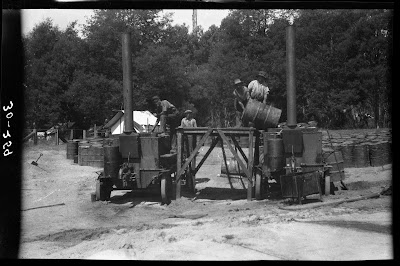Here are some postcards of Beaconsfield Upper (1). The photos may have been taken earlier, but two of the postcards are postmarked 1907 and I believe the cards were most likely produced around this time. The first 15 years or so of the twentieth century were a boom time for postcards - they enabled people to send a short message involving commercial transactions (see here) or for personal reasons (see here) or to extend seasonal greetings (see here) - the sort of transactions that we would make today with a quick phone call, email or text message. They were also a source of cheap souvenirs for holiday makers to either keep as a momento or to send to family and friends at home. There is an interesting history of postcards on the Australia Post website, see here.
This is Stoney Creek Road, Beaconsfield. Beaconsfield Upper was originally called Beaconsfield, but gained the 'Upper' due to the establishment of the Beaconsfield Railway Station, which opened December 1, 1879. The settlement which developed around the Station was at one time called Lower Beaconsfield, however when a new Post Office was established there in June 1891, the town around the Station was officially known as Beaconsfield and the town in the hills, Beaconsfield Upper (2). The town is also referred to as Upper Beaconsfield. Stoney Creek Road was once known as the Main Gembrook Road (3) and runs in an arc from the Beaconsfield-Emerald Road, where it returns to a few kilometres north. Stoney Creek is a tributary of the Cardinia Creek.
This is labelled Burke's Road, Beaconsfield. I presume this is Bourke's Creek Road which runs from the Healesville-Koo Wee Rup Road at Pakenham Upper and meanders along past the R.J. Chambers Flora and Fauna Reserve to the Beaconsfield-Emerald Road at Dewhurst, which is north Beaconsfield Upper. Bourke's Creek is a tributary of the Toomuc Creek. Bourke's Creek is most likely named for the Bourke family who took up Minton's Run on the Toomuc Creek in 1843 and established the La Trobe Inn, also known as Bourke's Hotel, on the Gippsland Road (now the Princes Highway) around 1850. You can read more about the Bourke family, here.
This area shown in this postcard is known as Charing Cross, a triangular area at the intersection of Beaconsfield-Emerald Road and St Georges Road and Salisbury Road. The image used in this postcard dates from 1898 (4) and shows the General Store. The term Charing Cross comes from the area in London and according to the Encyclopaedia Britannica the name derives from the Old English cerring (“a bend in the road” or “a turn”) and refers either to the nearby great bend in the River Thames or to a bend in the Roman road that ran west from London (5).
The first mention I could find in the newspapers of the term Charing Cross was in 1891, when George Craik (6) wrote to the Shire of Berwick on behalf of H. J. Williams (7) to erect a verandah on the shop.
South Bourke and Mornington Journal February 4, 1891
A bucolic scene.
Notes
(1) These are from my own collection - I was given three as a gift and purchased one of them. You know how it is, we all have to stay home due to Covid 19 and so on-line shopping fills in the time that I used to use for socialising and attending Historical Society activities!
(2) Wilson, Charles W. Upper Beaconsfield: an early history (The Author & the Upper Beaconsfield Association, 2013), p. 44.
(3) Wilson, op.cit., p. 31.
(4) Wilson, op.cit., p. 107, 107
(6) George Craik (1840-1918) You can read about George on Marianne Rocke's excellent and extensive website, Residents of Upper Beaconsfield, https://www.upperbeaconsfieldhistory.au/ George's entry is here
(7) H. J. Williams - not sure who this is - Marianne lists a Henry Jabez Williams and a Henry Joseph Williams, but they don't seem to be associated with the store.































